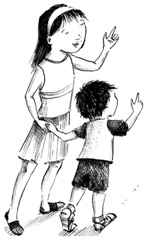There’s an interesting discussion going on over at January Magazine this week about whether we should establish a ratings system for books. The blogger over there, Tony, read an upcoming YA book billed for ages 14 and up. But some 70 pages in, Tony discovered content that he felt was a little, um, mature for the average 14-year-old reader:
“14 and up, I thought. 14 and up? 14 and up?! To me, ’14 and up’ is just another way of saying PG-13. . . . As the father of boys aged 13 and 9, who both love to read, I am now officially worried. Is this the stuff of books for Young Readers? For 14 and up?”
In the professional world of books, made up of librarians and publishers and booksellers, any complaint about the appropriateness of content tends to illicit a knee-jerk reaction and cry of censorship. And, frankly, when people are removing dictionaries from schools because they contain definitions of words that parents deem inappropriate, it’s not hard to see why. But Tony has a sensible argument: Shouldn’t there at least be some sort of rating so readers know what they are getting themselves into?
Continue reading →


 White Americans tend to raise children in nuclear families—just parents and kids—but in many cultures and many immigrant groups, extended families are deeply involved.
White Americans tend to raise children in nuclear families—just parents and kids—but in many cultures and many immigrant groups, extended families are deeply involved.  Nathalie Mvondo over at
Nathalie Mvondo over at